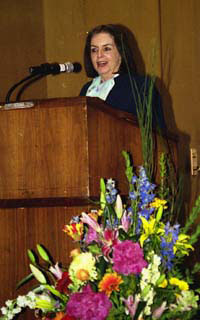Effects of Creative Collaborations on Learning Explored by Sussman Lecturer
Vera John-Steiner, TC's Sussman Visiting Professor, did double duty on December 3 presenting the Sussman Lecture and this year's second BookTalk. John-Steiner, the Presidential Professor of Linguistics and Education at the University of New Mexico, discussed her latest book, Creative Collaboration, for an audience of students, faculty, alumni and staff in the Horace Mann Auditorium.
Introduced by TC Trustee Laurie Tisch Sussman, for whom the professorship and lecture are named, and Associate Professor Marjorie Siegel, John-Steiner briefly outlined the premise of the book before joining in a panel discussion moderated by BookTalk's usual host, Richard Heffner of Channel 13's The Open Mind.
Noting that in studies of human development, the role of learning and patterns of achievement emphasize the individual and solo activities, John-Steiner said that in this book, "I have attempted to balance this concern." She does this by challenging the idea of primacy of the individual through examples of creative partnerships and collaborations between well-known artist and scientists.
Quoting Jean Paul Sartre's comments on his complex relationship with Simone de Beauvoir, she said, "‘We feed each other, we provide each other the gift of confidence.' Her confidence in him never wavered-it was that gift that allowed him to construct new ideas."
Einstein, she said, had 100 collaborators but was usually pictured alone. It was the conversations he had with colleagues such as Neils Bohr, that contributed to the construction of contemporary physics.
Picasso and Braque collaborated for seven years on Cubism. "During that time, they were unable to finish a day without seeing each other's work," she said. "They signed the back of the artwork to keep the focus on the innovation rather than who did the work."
"In partnerships, we see each other and ourselves through the eyes of the other," John-Steiner concluded. "Through their support, we explore new parts of ourselves. Together we create our futures."
In the discussion that followed with Heffner and Professor James Borland and Professor Celia Genishi, John-Steiner told how after one of her talks a gentleman came up to her and said she was trying to destroy western civilization. "I thought I was trying to strengthen civilization, not just western civilization," she said. "Collaboration can take many forms. It is not an attack on individual achievement, it is an expansion. If you take enormous risks, you need enormous support."
Borland queried John-Steiner's idea that "construction of a new mode of thought relies on and thrives with collaboration," asking whether creation of a new way of looking at things can only come about within a partnership. She explained that collaboration does not require people actually sitting together but that before you can change knowledge, you need to acquire knowledge. "Changing the existing tenets of what we have been taught is too great to accomplish alone."
Citing the physicists of the 1920s and 1930s as an example, John-Steiner said it was through interactions and reading each other's work that they could give new meaning to words such as "the atom." When challenging the gatekeepers of one's field, she added, support from each other is necessary.
When asked about the examples of collaborators she chose for her book, John-Steiner explained that while writing other books, she realized that certain people collaborated extensively. "The theme of collaboration crept up on me," she said, until she found her role going from one of documenting examples of collaboration to one of spokesperson for it. "It is that change you are hearing today," she said.
To a question about creative collaboration as the basis for an educational philosophy, John-Steiner described how she assigned her students the responsibility of giving each other a peer examination in place of a mid-term exam. "Students fashioned questions for each other," she explained. "They sat together and discovered they know a lot more about a topic than could be elicited from them during a traditional exam."
This kind of collaboration, she said, works well on the graduate school level, and pre-school and elementary levels also show promise.
"The real problem," she added, "is working to establish collaborative learning with high school students who are competing for college."
"I do not suggest that there be a single model of learning," John-Steiner noted. "Collaboration is a choice, not an assignment." She added that some public schools schedule collaborative time for teachers whether they want to or not. "That is the opposite of what I am writing here."
Should a collaborator's personality, Heffner asked, be one of strength or weakness. Neither, she responded, saying that collaborators are "people who are ready, who have established a track record. The best collaborators are dialog thinkers. People who discover their best ideas when engaged in interaction with others."
Genishi commented that collaboration could be difficult. John-Steiner responded, "In order to collaborate you have to have a strong ego, a flexible ego, an ability to negotiate and recognize when someone has better ideas than you do." She added the traits of patience, trust and the willingness to argue without being overwhelmed by criticism.
In addition to her role as Sussman Lecturer, John-Steiner taught two courses this fall entitled "Creativity: Nature or Nurture" and "The Life and Works of Vygotsky" in the Department of Curriculum and Teaching. She returns to the University of New Mexico in the Spring.
Published Monday, May. 20, 2002
